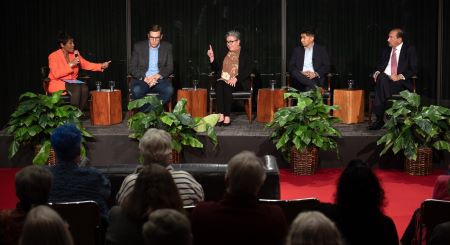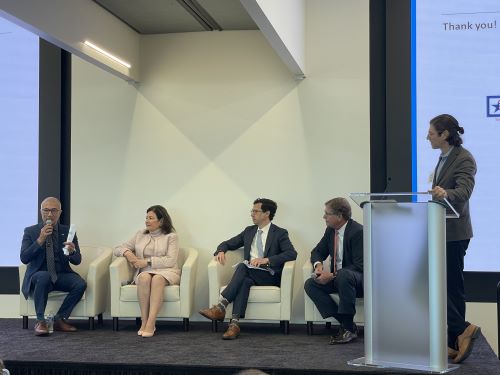The Four Dangerous Fallacies of the Trump-Cotton-Perdue Immigration Plan
 The following article was authored by Immigration Works President Tamar Jacoby and originally published on New York Daily News.
The following article was authored by Immigration Works President Tamar Jacoby and originally published on New York Daily News.
President Trump gets one big thing right when he talks about immigration: We need an immigration system that serves American interests, putting American workers first, not the rights of immigrants or would-be immigrants. Last week, he announced a set of principles that he hopes will guide Congress in crafting new immigration legislation. He and his allies in Congress, most notably Sens. Tom Cotton (R-Ark.) and David Perdue (R-Ga.), defend them by claiming they will create jobs, reduce unemployment and raise Americans' wages — particularly for the working class. These are essential goals, and the President's promises will resonate with millions of workers and families struggling to keep up with globalization and technological change.
Unfortunately, the "merit-based" reforms Trump and his allies propose are unlikely to advance any of these aims and, if anything, will hurt American workers by slowing economic growth and eliminating jobs.
The President's "merit-based" immigration proposal is based on four dangerous fallacies.
The first is that only highly skilled workers contribute to the economy and create jobs for Americans. The President and his allies are right: skilled immigrants drive innovation and productivity, spurring economic growth and creating jobs.
But less-skilled immigrants too contribute to the economy. On the whole, they are different from American workers — less-educated, less-skilled, with weaker communications skills — and because they are different, they fill job niches that would otherwise go unfilled, rounding out the workforce at many firms and enabling businesses to expand.
Consider the owner of a small restaurant group who wants to open another eatery. If he can't find workers willing to take jobs bussing tables and washing dishes, he won't be able to open a new restaurant. But if he can hire dishwashers and moves ahead with the project, he will likely hire an American chef, American waiters and one or more American managers. The venture will also create work for an American architect, an American designer, nearby farmers, a bank, a laundry, a hauling firm and a host of other local businesses.
The second fallacy: that fewer immigrants would be better for the economy. The centerpiece of the President's proposal — arguably its most radical provision — would cut legal immigration in half by sharply reducing family-based visas in favor of employment-based admissions. In this case too, the President and his allies get the answer half right.
The U.S. immigration system puts a heavy emphasis on family-based migration, with the overwhelming majority of the green cards issued every year going to relatives of other immigrants already living in the U.S. Just 7% of permanent visas go to newcomers coming to the country expressly to work. Most other developed countries balance these two categories very differently, often reserving a plurality or majority of visas for employment-based immigrants - and the U.S. should consider rebalancing.
What the President's proposal does not recognize: Most immigrants admitted on family-based visas get a job when they get here. Foreign-born men are much more likely to be in the labor force than native-born men. Immigrants are less likely to be unemployed. According to a group of leading economists convened in 2016 by the National Academy of Sciences, newcomers and their children will account for the "vast majority" of labor force growth in years to come.
And economists across the board agree: There can be little economic growth without an expanding labor force.
The third fallacy: that less-skilled immigrants reduce wages for most Americans. Trump and his allies accept the conventional wisdom that admitting thousands of less-skilled, low-paid foreigners reduces wages for native-born workers. This sounds plausible, and many Americans believe it to be true.
The only problem: Economists have been scouring wage trends for many years and cannot find a significant wage effect. Virtually no economist, even those highly skeptical of immigration, believes that it reduces wages for U.S. workers who have graduated from high school - the overwhelming majority of the U.S. labor force. Economists differ somewhat about the effect on Americans without a high school diploma — today, less than 10% of the workforce.
But even in this case, researchers agree that the effect is small — perhaps 5% over 20 years. Meanwhile, even these less-educated Americans benefit from cheaper food, housing, clothing and other goods and services — cheaper thanks to the relatively low cost of immigrant labor.
The fourth: that the government knows how to predict labor needs and determine which workers have "merit" in the eyes of employers. The President and his allies propose to dramatically change the way we select immigrants, moving to a point system they say is modeled on programs in place in Canada and Australia.
This too sounds good in theory: recruit the super-skilled and admit only the best and brightest.
But here too, policymakers in Canada and Australia have found, what sounds good on paper doesn't always work. Both countries have moved away from admissions based solely on applicants' resumes, taking more and more account over the years of national labor markets, employers' needs, applicants' prior experience in the destination country and other variables that have nothing to do with skills.
Even more concerning, most U.S. employers strongly oppose a point system. The last time one was proposed, in 2007, high-tech companies, hospitals and financial firms were all but unanimous, arguing that only they, not the government, could identify the skills and talent they need to grow their operations and continue contributing to the economy.
It's a policy priority in Washington and beyond: Lawmakers in both parties rightly want to help the working class, creating jobs and raising wages. But new immigration legislation based on a set of proven fallacies will likely do more harm than good. The President and Congress should rethink. There has to be a better way.








